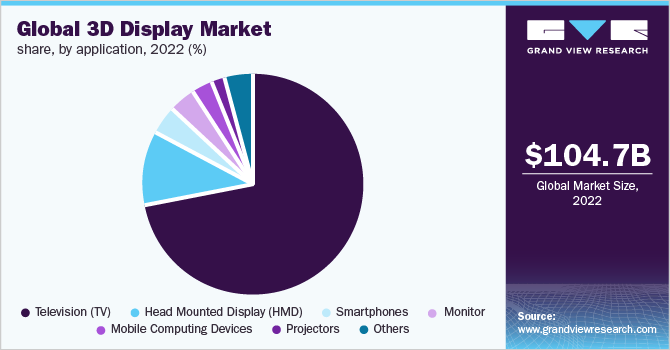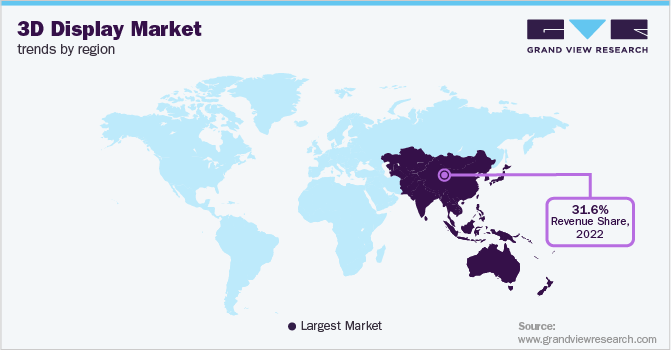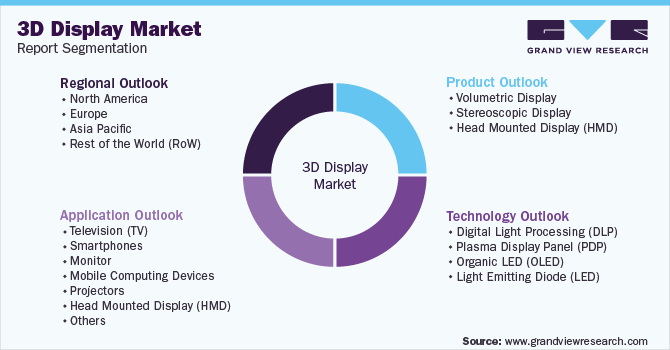- Home
- »
- Display Technologies
- »
-
3D Display Market Size, Share, Growth & Trends Report, 2030GVR Report cover
![3D Display Market Size, Share & Trends Report]()
3D Display Market Size, Share & Trends Analysis Report By Product (Volumetric Display, Stereoscopic Display, Head Mounted Display), By Technology, By Application, By Region, And Segment Forecasts, 2023 - 2030
- Report ID: GVR-2-68038-003-3
- Number of Pages: 100
- Format: Electronic (PDF)
- Historical Range: 2018 - 2021
- Industry: Semiconductors & Electronics
Report Overview
The global 3D display market was valued at USD 104.69 billion in 2022 and is expected to register a compound annual growth rate (CAGR) of 19.0% from 2023 to 2030. Increasing demand for 3D technology designed for gaming industries and home entertainment is among the major factors driving the growth of the 3D display market. The 3D display market is expected to increase significantly during the forecast period owing to the declining prices of electronic devices and the increasing disposable income of individuals globally. The gaming industry has seen significant shifts in the gaming experience, technology, and graphics during the past few years. The industry is moving toward improving the full gaming experience with 3D technology, accelerating 3D display market growth. In addition, rising interest in LED and OLED technologies that offer superior performance and picture quality compared to traditional display technologies is expected to help the overall market.

Companies in the 3D display market are coming up with new technologies for attracting customers enabling them to gain better traction in the market. For instance, in May 2022, Sony Corporation teamed up with Theta Labs, Inc. (U.S. based Software Company) to launch 3D NFTs, with its design will be compatible with the Spatial Reality Device (SRD) technology of Sony Corporation.
The major highlight of the product is its ability to sync an image to be compatible with the user's eye movement for creating 3D effects. The growing incorporation of these displays in various devices such as smartphones, monitors, notebook PC, TVs, and digital photo frames is also in a position to play a vital role in the growth of the 3D display market.
During the initial phase of COVID-19, demand for smartphones, televisions, and similar non-essential consumer electronics witnessed a decline, attributed to consumers' delayed spending on products, which had affected the 3D display market. However, with post lifting of the restrictions, demand for consumer electronic products had increased owing to the online classes and working from home.
Emerging economies involving India and China are expected to experience remarkable growth in the forecast period due to the extended base of the middle-class population and increasing standards of living. Projectors and monitors, amongst the key applications of 3D displays, are anticipated to register a sudden increase in sales shortly due to shifting consumer preferences and rising demand for the high-definition graphics. High cost, combined with a lack of 3D content and health-related issues, including nausea, motion, eye disorders, and headaches, is expected to hinder the 3D display market growth.
However, growing consumer choices and awareness about HD technology resulted in the 3D display market growth. Additionally, the adoption of digital cinema screens can offer a 3D viewing experience and increasing consumer preference toward 3D movies will also drive the development of the 3D display market. Although high price is a factor derailing the wider adoption of the 3D display, as time passes, prices are expected to come down owing to technological advancements and increased purchasing power.
Moreover, major companies in the 3D display market are offering products with additional features, helping the companies to gain traction in the market. The 3D display companies are getting into partnerships/collaborations to share technology for developing new products to gain the upper hand in the 3D display market. Such factors gain lucrative opportunities in the growth of the market.
For instance, in April 2022, Apple Inc. announced its plan to HMD display MR devices mounted with Micro OLED and OLED displays. Such R&D happening in the HMD segment will fuel the growth of the HMD segment of the 3D display market during the forecast period.
The HMD segment of the 3D display market by product is expected to have significant growth in the North American region and other areas. The development of the HMD segment can be attributed to the increase in the use of HMDs in various aspects of life, including military, aviation, engineering, and research. Moreover, companies in the 3D display are coming up with displays with additional features for HMD driving the growth of the HMD segment.
Product Insights
The stereoscopic displays segment of the 3D display market by product is estimated to occupy the largest market share during the forecast period 2023-2030. The growth of the stereoscopic segment can be attributed to high adoption in the gaming and entertainment industries for applications, including academics, movies, animations, and video games, among others. Furthermore, improvements in autostereoscopic technology and lower costs of the stereoscopic products have also contributed to the growth.
The HMD segment is expected to register the highest CAGR exceeding 22.0% during the forecast period 2023-2030, owing to its growing popularity in science, engineering, and medicine. The growth of the HMD segment can also be attributed to quick technological advancements and reduced prices of 3D displays. Moreover, the viewing experience offered by HMD also heavily contributed to the growth of the stereoscopic display segment in the 3D display market.
Technology Insights
Based on technology, the market is segmented into DLP, PDP, OLED, and LED. The LED segment accounted for the largest market share accounting for more than 70.0% of the 3D display market in 2022. LED panels are commonly used as backlighting solutions for enhancing image quality and getting a faster response. Several companies in the 3D display market are focused on developing LED-based displays for various applications such as TVs, monitors, smartphones, and HMDs.
The OLED technology segment is expected to record the highest CAGR exceeding 25.0% during the forecast period 2023 to 2030. The growth of OLED can be attributed to rising adoption across several devices and enhanced picture quality and performance as compared to traditional displays. Additionally, increased penetration of OLED in smartphones is another factor that fueled the OLED segment's growth in the 3D display market by technology.
Application Insights
By application, the TV segment of the 3D display market is expected to have the largest revenue in 2022. A large chunk of the growth of the TV segment can be attributed to a shift in consumer preference from going to theatres to being entertained in the comfort of home on TVs or computers, post the COVID-19 pandemic. This change encouraged TV manufacturers to add 3D displays to their product portfolios. These TVs offer a better visualization impact, offering enhanced picture quality. Consumer Electronics Manufacturers (CEMs) are promoting 3D display TVs as high-end devices with premium features driving the growth of the TV segment.
The smartphone sub-segment is also expected to have significant growth exceeding 21.0% in the 3D display market during the forecast period. The change can be attributed to high competition among smartphone vendors to offer better features to gain the smartphone market's upper hand. Moreover, the mobile gaming industry has been coming up with games that require enhanced visual graphics, which has also facilitated the growth of the smartphone segment during the forecast period.

The HMD sub-segment is expected to expand with the highest CAGR from 2023-2030. The growing use of HMDs and smart glasses across numerous applications in several industries accompanies the segment's growth. The visual experience HMD offers is used in multiple industries, including medical, gaming, and aeronautical. HMD catering wider part of the population is also among the major factors attributed to its growth in the 3D display market during the forecast period.
The smartphone sub-segment is expected to post a significant CAGR during the forecast period 2023-2030, owing to the rising technology integration in mobile devices. Changing lifestyles are driving people to buy high-end smartphones, which in turn is generating the adoption of 3D displays. However, original equipment manufacturers (OEMs) concentrate on 3D data visualization solutions for smartphones, fueling the market growth.
Regional Insights
Asia Pacific region led the market and accounted for over 31.65% of the global revenue share in 2022. Technological advancements, increasing infiltration of smartphones and a high acceptance rate of digital services are the crucial aspects influencing the development of the regional market. Furthermore, the rolling demand for video games across the globe is accelerating the adoption of stereoscopic displays. Growing the use of 3D display technology in entertainment, defense, gaming, and engineering simulations will also strengthen the market throughout the forecast period.

Asia Pacific is projected to develop as the fastest-increasing region during the same period, owing to shifting customer preferences and increasing disposable household income. The presence of main technology players such as LG, Samsung Electronics, Sony Corporation, Panasonic Corporation, and Fujifilm Holdings Corporation is also assisting the growth of the Asia Pacific region in the 3D display market.
Key Companies & Market Share Insights
The 3D display market is competitive due to the numerous prominent companies such as LG Electronics, Sony Corporation, SAMSUNG, AUO Corporation among others. Companies have been concentrating on organic growth tactics, which include product innovation, R&D investments, and value-added features, to expand their product portfolios and increase their share in the market.
Manufacturers are focused on evolving new and advanced products, including smart TVs and Ultra-HD 4K TVs, which meet clients' growing needs. For instance, in August 2022, Sony launched the new A95K OLED TV, which offers cognitive processor XR technology, enabling an immersive viewing experience and delivering the creator’s actual content. Such initiatives help not only specific companies but also are healthy for the growth of the 3D display market. Some prominent players in the global 3D Display market include:
-
AUO Corporation
-
BOE Technology Group Co., Ltd.
-
Innolux Corporation
-
Japan Display Inc.
-
LG Electronics
-
SAMSUNG
-
SHARP CORPORATION
-
Sony Corporation
-
Truly Semiconductor Co., Ltd.
-
Vision ox Company
3D Display Market Report Scope
Report Attribute
Details
Market size value in 2023
USD 122.44 billion
Revenue forecast in 2030
USD 413.13 billion
Growth rate
CAGR of 19.0% from 2023 to 2030
Base year for estimation
2022
Historical data
2018 - 2021
Forecast period
2023 - 2030
Quantitative units
Revenue in USD billion and CAGR from 2023 to 2030
Report coverage
Revenue forecast, company ranking, competitive landscape, growth factors, trends
Segments covered
Product, technology, application, region
Regional scope
North America, Europe, Asia Pacific, Rest of the World
Country scope
U.S.; Canada; U.K.; Germany; France; Italy; Spain; China; India; Japan; Australia; South Korea; Brazil; Mexico; UAE; Saudi Arabia
Key companies profiled
AUO Corporation; BOE Technology Group Co., Ltd.; Innolux Corporation; Japan Display Inc.; LG Electronics; SAMSUNG; SHARP CORPORATION; Sony Corporation; Truly Semiconductor Co., Ltd.; and Vision ox Company
Customization scope
Free report customization (equivalent to up to 8 analysts’ working days) with purchase. Addition or alteration to country, regional & segment scope.
Pricing and purchase options
Avail customized purchase options to meet your exact research needs. Explore purchase options.
Global 3D Display Market Segmentation
This report forecasts revenue growth at global, regional, and country levels in addition to provides an analysis of the latest industry trends and opportunities in each of the sub-segments from 2018 to 2030. For this study, Grand View Research has segmented the global 3D display market report based on the product, technology, application, and region:

-
Product Outlook (Revenue, USD Billion, 2018 - 2030)
-
VolumetricDisplay
-
StereoscopicDisplay
-
Head Mounted Display (HMD)
-
-
Technology Outlook (Revenue, USD Billion, 2018 - 2030)
-
Digital Light Processing (DLP)
-
Plasma Display Panel (PDP)
-
Organic LED (OLED)
-
Light Emitting Diode (LED)
-
-
Application Outlook (Revenue, USD Billion, 2018 - 2030)
-
Television (TV)
-
Smartphones
-
Monitor
-
Mobile Computing Devices
-
Projectors
-
Head Mounted Display (HMD)
-
Others
-
-
Regional Outlook (Revenue, USD Billion, 2018 - 2030)
-
North America
-
U.S.
-
Canada
-
-
Europe
-
U.K.
-
Germany
-
France
-
Italy
-
Spain
-
-
Asia Pacific
-
India
-
China
-
Japan
-
Australia
-
South Korea
-
-
Rest of the World (RoW)
-
Brazil
-
Mexico
-
UAE
-
Saudi Arabia
-
-
Frequently Asked Questions About This Report
b. The global 3D display market size was estimated at USD 104.69 billion in 2022 and is expected to reach USD 122.44 billion by 2023.
b. The global 3D display market is expected to grow at a compound annual growth rate of 19.0% from 2023 to 2030 to reach USD 413.13 billion by 2030.
b. Asia Pacific dominated the 3D display market with a share of 31.65% in 2022. This is attributable to technological advancements, increasing penetration of smartphones, and high adoption rate of digital services.
b. Some key players operating in the 3D display market include Samsung Electronics, LG Electronics, Panasonic Corporation, Sony Corporation, Sharp Corporation, Toshiba Corporation, and Fujifilm Holdings Corporation.
b. Key factors that are driving the 3D display market growth include the growing demand for 3D displays from the gaming industry and the growing popularity of OLED and LED technologies, which offer improved picture quality and performance compared to traditional display technologies.
Share this report with your colleague or friend.
![gvr icn]()
NEED A CUSTOM REPORT?
We can customize every report - free of charge - including purchasing stand-alone sections or country-level reports, as well as offer affordable discounts for start-ups & universities. Contact us now
![Certified Icon]()
We are GDPR and CCPA compliant! Your transaction & personal information is safe and secure. For more details, please read our privacy policy.
We are committed towards customer satisfaction, and quality service.
"The quality of research they have done for us has been excellent."





